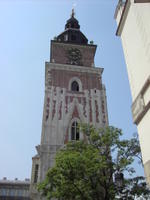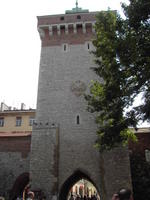 Kraków is an awesome city. It's full of old mediaeval buildings that managed to survive both world wars, which is quite impressive. This picture is the 'Cloth Hall' in the middle of Kraków's Rynek, and is basically a shopping mall that has been in continuous operation for 700 years. Kraków's Rynek is apparently the biggest town square in Europe, and definitely looks large enough to claim such a title. This building is beautiful on the outside and just as impressive inside.
Kraków is an awesome city. It's full of old mediaeval buildings that managed to survive both world wars, which is quite impressive. This picture is the 'Cloth Hall' in the middle of Kraków's Rynek, and is basically a shopping mall that has been in continuous operation for 700 years. Kraków's Rynek is apparently the biggest town square in Europe, and definitely looks large enough to claim such a title. This building is beautiful on the outside and just as impressive inside. This is a picture of the Town Hall Tower. The town hall has since departed after being demolished in the 1820s (I don't know why). The hall had a dungeon area containing torture chambers and a popular beerhouse. Of course. These lowers levels of the town hall remain and have been converted to a theatre and cafe. This tower was completed by the end of the 13th century and now leans slightly due to a strong wind in 1703. It is possible for people to climb to the top of this tower and see the view from above, which I think would be amazing, but was just one of the many things that I didn't know about until I returned from Kraków, so I'll have to make the trek up the, apparently, 100 steep and narrow stairs.
This is a picture of the Town Hall Tower. The town hall has since departed after being demolished in the 1820s (I don't know why). The hall had a dungeon area containing torture chambers and a popular beerhouse. Of course. These lowers levels of the town hall remain and have been converted to a theatre and cafe. This tower was completed by the end of the 13th century and now leans slightly due to a strong wind in 1703. It is possible for people to climb to the top of this tower and see the view from above, which I think would be amazing, but was just one of the many things that I didn't know about until I returned from Kraków, so I'll have to make the trek up the, apparently, 100 steep and narrow stairs. Just off the market square I found a "classy" McDonald's restaurant. It's completely devoid of the familiar fluoro yellow arches and instead has actual 'golden' arches. Of course, the interior is just as tacky as every other Maccas on the globe. I found another one near the Rynek but it was the tacky version, which was a shame.
Just off the market square I found a "classy" McDonald's restaurant. It's completely devoid of the familiar fluoro yellow arches and instead has actual 'golden' arches. Of course, the interior is just as tacky as every other Maccas on the globe. I found another one near the Rynek but it was the tacky version, which was a shame.
This is an old barbican which was used to guard the entrance to Kraków, through the Florian's Gate (Bramka Floriańska, I think). It was once surrounded by a moat and provided quite good defense of this side of the city. It was quite a marvel of mediaeval architecture. I would like to say that the moat contained crocodiles, but alas, I don't think it did. At least there was no mention of dangerous water-dwelling creatures.

This is Florian's Gate. Impressively, sections of the old wall still exist on either side, including the battlements. The eagle visible on the tower is the symbol of Poland. Nathaniel suggested that the eagle's facial expression makes it look as though the tail is actually something painful that has been forcefully inserted into the poor creature's anus. He's quite right, it does look like this, and I now find the eagle amusing wherever I see it (which is everywhere in this country - it's on every coin for one thing).
 This is the Wawel Castle, Kraków's royal residence where many (perhaps most?) of the Polish Kings lived. I don't really have a good picture of it, as the sun was too bright in one direction and from the streets around the castle, much of it is obscured by trees. We didn't get to enter the castle because visiting hours had ended by the time we arrived at the gate, so I will have to return to Kraków in the near future to see it from the inside. It was a nice castle, from the outside. It's not as big as the palaces at Schoenbrunn or in Prague, but definitely larger than that in Bratislava. This castle has a 'lived-in for many centuries' appearance, as there are sections from many different periods of architecture, which adds to the interest.
This is the Wawel Castle, Kraków's royal residence where many (perhaps most?) of the Polish Kings lived. I don't really have a good picture of it, as the sun was too bright in one direction and from the streets around the castle, much of it is obscured by trees. We didn't get to enter the castle because visiting hours had ended by the time we arrived at the gate, so I will have to return to Kraków in the near future to see it from the inside. It was a nice castle, from the outside. It's not as big as the palaces at Schoenbrunn or in Prague, but definitely larger than that in Bratislava. This castle has a 'lived-in for many centuries' appearance, as there are sections from many different periods of architecture, which adds to the interest. This is the famous Basilica of the Virgin Mary in Kraków (Kościoł Mariacki). It's quite unusual that such a church would have two vastly different towers. One myth that I've been told is that each tower was being built by one of two brothers and they were competing to see who could build the highest spire. One of the brothers realised that there was no way that his spire would be the highest and so he killed the other one. I don't know how much truth is in that story but it's one possible explanation. Today, the taller tower (the one on the left) actually belongs to the municipality of Kraków and every hour on the hour the Kraków signal is played on trumpet. The characteristic signal is played towards the west, then the east, south and north. I didn't hear the signal because I didn't know about it until I returned to Gliwice (so another reason to return to Kraków). Apparently the signal doesn't finish, but rather comes to an abrupt end. It was traditionally played to signal the opening and closing of the city gates as well as to warn the citizens of danger, such as a fire, or approaching enemies. The reason for the abrupt end to the current signal is to commemorate a bugler who was shot in the throat by a Tatar archer while he was warning the citizens of the approaching army in 1241.
This is the famous Basilica of the Virgin Mary in Kraków (Kościoł Mariacki). It's quite unusual that such a church would have two vastly different towers. One myth that I've been told is that each tower was being built by one of two brothers and they were competing to see who could build the highest spire. One of the brothers realised that there was no way that his spire would be the highest and so he killed the other one. I don't know how much truth is in that story but it's one possible explanation. Today, the taller tower (the one on the left) actually belongs to the municipality of Kraków and every hour on the hour the Kraków signal is played on trumpet. The characteristic signal is played towards the west, then the east, south and north. I didn't hear the signal because I didn't know about it until I returned to Gliwice (so another reason to return to Kraków). Apparently the signal doesn't finish, but rather comes to an abrupt end. It was traditionally played to signal the opening and closing of the city gates as well as to warn the citizens of danger, such as a fire, or approaching enemies. The reason for the abrupt end to the current signal is to commemorate a bugler who was shot in the throat by a Tatar archer while he was warning the citizens of the approaching army in 1241.Overall I really liked Kraków, and I do plan to return one day, hopefully for a weekend or something.

No comments:
Post a Comment